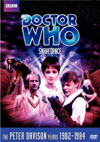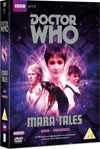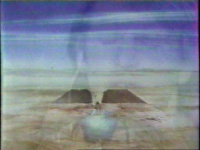DVD Extras include:
However, my opinion was not always so favourable, particularly when I first saw it. Writer Christopher Bailey continues the anti-tech writing style he began in this story's prequel "Kinda" (story no. 119), which denied my young thirst for laser beams, materializations, physical action, and most of the "magical" effects surrounding new sci-fi processes that fueled my early interest in the genre. Bailey has other aims in mind, and chiefly sustains the first three episodes with explorations of culture, character, and a form of long-forgotten crystal technology which few still believe in - all of which supports what I now believe to be the most important aspects of good science fiction. The final episode then layers in spiritual elements critical to a superb dramatic climax that satisfies on multiple levels, and has the added power of being able to positively affect viewers' lives, becoming one of the tours-de-force for Peter Davison's era.
Nyssa is seen trying out the first completely new everyday costume she's had since she joined the show, and Sarah Sutton and Peter Davison devise a few enjoyable additions to their first scenes surrounding this, thankfully keeping it tasteful and minimal enough not to interrupt the flow of the story. The new costume is welcome variety on the show, but sadly isn't any improvement on Nyssa's season 19 look. Thankfully, it only features for one story, until yet more variety wanders out of the TARDIS's wardrobe room.... Once more for season 20, Nyssa gets to play the chief companion to the Doctor as she did in "Arc of Infinity" (story no. 124). Although continuing to do an excellent job of it, there is less for her to do in this story, and less dramatic meat for her to get her teeth into. It is Janet Fielding who has far more acting to do, although only a relatively small percentage of it is as her regular character Tegan. Thankfully, a few nice new character bits still manage to come out for Tegan, such as the glimpse of what she was like when she was six years old. The Mara also turns out to be an enjoyable and successful mix of acting, special effects, and backstory mystery, having its most profound effect in the imagination. While all the guest actors do excellent work in their roles, John Carson's Ambril has become a particular favourite of mine. Both his passions and his intolerances come out clearly, humorously, and with much charisma. Superb. And if you're looking for a little alien culture to show itself on the Doctor's travels through time and space, Ambril's ramblings are actually rather interesting and rewarding to listen to. Which brings us to another point. It's easy to see how the production team of the new millennium might try to set a story such as this in colonial India a few centuries ago, as the parallels are great. But it achieves more in the sci-fi genre by being a clash between two completely alien cultures with the freedom to be anything, become anything, and have any kind of history that suits the adventure at hand. Sweet. Just what I look for these days, and precisely what is in far too short supply in the 2005-2007 years of the show. While there is every reason to believe that "Snakedance" features the same interplanetary Federation as was seen exploring the planet Deva Loka in "Kinda", there really is nothing in either story to indicate that this Federation is Earth-based, as many fans seem to have assumed. In my mind, it's alien, as it should be, and if we ever see any more of it on Doctor Who, it may yet surprise us with even stranger cultural twists. One of the things that makes these characters work so well is the way they are all so easily understandable - the idle prince, the socially climbing queen, the greedy showman, even the street vendor pushing trinkets. They're all real at first sight, unlike many of the more experimental characterizations one will encounter during the Sylvester McCoy era. The one bit that doesn't really work for me is the puppet play in the market - which of course doesn't really need to be anything too real in the first place. The plot of "Snakedance" is fairly well-constructed, and a bit better than "Kinda". Each episode works well both when viewed on its own, and in quick succession as a whole story. Although the progress and enjoyment of the story easily survive its routine capture and escape sequence, the adventure likely would have been better and more popular had more traditional Doctor Who action been used instead.
Stillpoint QuestThe final segments incorporate a whole new level into the story, and it is only here that Peter Davison's Doctor's mythological role in this tale is really defined, making sense of what might have been perceived as character flaws earlier in the story. There is much more to say on this topic, but I will of course avoid spoilers here by saving it all for the In-depth Analysis version of this review, along with how and why "Snakedance" ties in with our feature article: "Recipe for Health".For now, I'll just say that my experience suggests that the information expressed simply and helpfully here, has the potential to reach beyond into viewers' lives, consciously or unconsciously, and have impact. Even after dismissing this story in my youth, I found many profound lines coming back to me whenever I needed them most.... along with images, sounds, and music from the program. Likely without realizing it, Doctor Who audiences were given a glimpse of something brilliant and real that many have yet to tap into.
"Snakedance" undoubtedly has one of the most dramatically riveting, successful, and unique conclusions of any Doctor Who story, with some effective and bizarre visuals to boot. And the minute one considers the Mara to be an external representation of any unwanted or unconstructive thoughts in the mind, the conclusion reveals rare layers of mental, emotional and spiritual wisdom. Though I heartily rank this sequel much higher than its predecessor "Kinda" (story no. 119), I will acknowledge that, at least for the first three episodes, the excellence of "Snakedance" is centered primarily in its dialogue and performances, while "Kinda" is perhaps a bit more interesting visually, and horror-fans may easily find "Kinda" a bit closer to what they're looking for. "Snakedance" dominates in terms of spiritual/philosophical wisdoms, however, and has a much better and more focused concluding episode. Although it certainly helps to have seen "Kinda" before tackling "Snakedance", I don't really believe it necessary. You can still start with "Snakedance", and if intrigued to know more history and backstory, check out "Kinda" at a later point.
This story is available on DVD and VHS video. Click on the Amazon symbol for the location nearest you for pricing and availability:
Comments on this article are welcome. You may contact the author from this page:
the novel "Buddha: A Story of Enlightenment", by Dr. Deepak Chopra.
|










